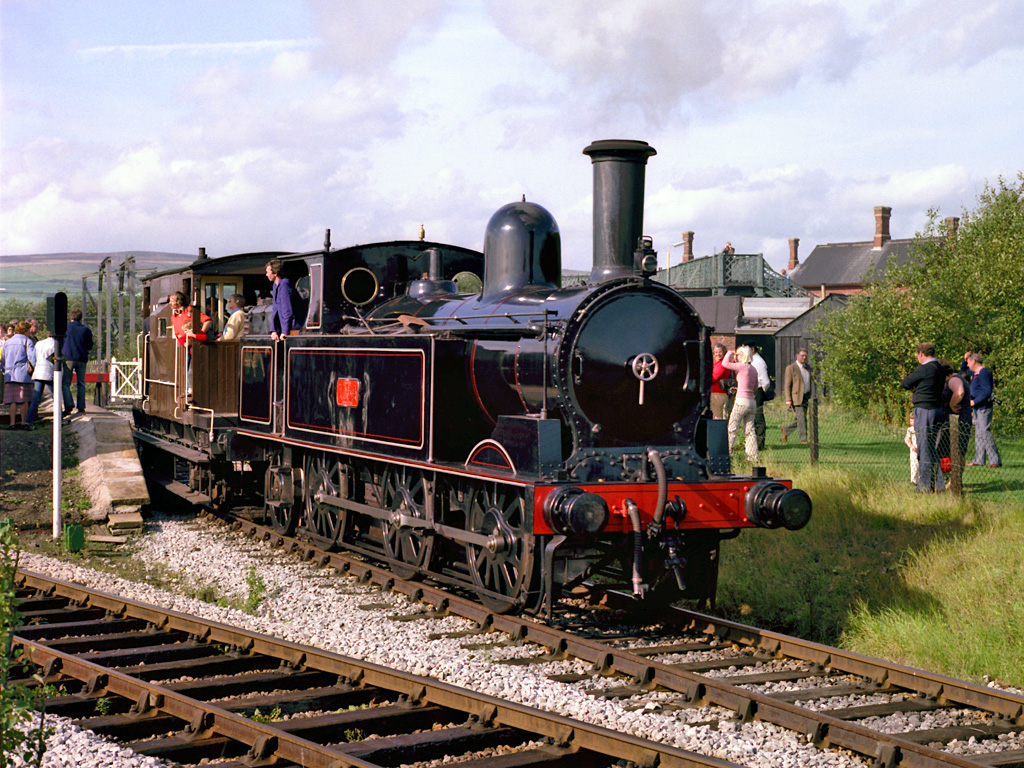LNWR Webb Coal Tank on:
[Wikipedia]
[Google]
[Amazon]
The

 One Coal Tank number BR 58926, ex-LMS 7799, originally LNWR 1054, the 250th one built, has survived in preservation on the
One Coal Tank number BR 58926, ex-LMS 7799, originally LNWR 1054, the 250th one built, has survived in preservation on the
Goods Engines of LNWR
0-6-2T locomotives Webb Coal Tank Railway locomotives introduced in 1881 Standard gauge steam locomotives of Great Britain C1′ n2t locomotives Freight locomotives {{UK-steam-loco-stub
London and North Western Railway
The London and North Western Railway (LNWR, L&NWR) was a British railway company between 1846 and 1922. In the late 19th century, the L&NWR was the largest joint stock company in the United Kingdom.
In 1923, it became a constituent of the Lo ...
(LNWR) Webb Coal Tank is a class of 0-6-2T steam locomotive. They were called "Coal Tanks" because they were a side tank
A tank locomotive or tank engine is a steam locomotive that carries its water in one or more on-board water tanks, instead of a more traditional tender. Most tank engines also have bunkers (or fuel tanks) to hold fuel; in a tender-tank locomot ...
version of Webb's standard LNWR 17in Coal Engine
The LNWR 17in Coal Engine was a class of 0-6-0 steam tender engines designed by Francis Webb for the London and North Western Railway. They were simple locomotives and in UK service they were very reliable. "17in" refers to their cylinder ...
, an 0-6-0
Under the Whyte notation for the classification of steam locomotives, represents the wheel arrangement of no leading wheels, six powered and coupled driving wheels on three axles and no trailing wheels. This was the most common wheel arrangemen ...
tender engine for slow freight trains.
Design
The design was introduced in 1881 by F.W. Webb and had the same cheaply producedcast iron
Cast iron is a class of iron–carbon alloys with a carbon content more than 2%. Its usefulness derives from its relatively low melting temperature. The alloy constituents affect its color when fractured: white cast iron has carbide impuriti ...
wheels and H-section spokes as the tender engines. A trailing radial axle A radial axle is an axle on a railway locomotive or carriage which has been designed to move laterally, along the arc of a circle, when entering a curve in order to reduce the flange and rail wear. William Bridges Adams was an early developer of rad ...
supporting the bunker
A bunker is a defensive military fortification designed to protect people and valued materials from falling bombs, artillery, or other attacks. Bunkers are almost always underground, in contrast to blockhouses which are mostly above ground. ...
was added also with two similarly cast iron wheels. Three hundred were built between 1881 and 1897.
Operational history
Four (LNWR nos. 178, 484, 1257, 69) were withdrawn in January–February 1920 and a further four (LNWR nos. 142, 994, 782, 1012) in July and November 1922, so at the 1923grouping
Grouping may refer to:
* Muenchian grouping
* Principles of grouping
* Railways Act 1921, also known as Grouping Act, a reorganisation of the British railway system
* Grouping (firearms), the pattern of multiple shots from a sidearm
See also ...
, 292 passed to the London Midland and Scottish Railway
The London, Midland and Scottish Railway (LMSIt has been argued that the initials LMSR should be used to be consistent with LNER, GWR and SR. The London, Midland and Scottish Railway's corporate image used LMS, and this is what is generally ...
(LMS). They were renumbered from the LNWR's random allocation based on vacant numbers, to a solid block sequence 7550–7841, and given the power classification
A number of different numbering and classification schemes were used for the locomotives owned by the London, Midland and Scottish Railway (LMS) and its constituent companies; this page explains the principal systems that were used.
The followi ...
1F. Many locomotives still in service in 1934 were renumbered by the addition of 20,000 to their number.
Sixty-four locomotives passed into British Railways
British Railways (BR), which from 1965 traded as British Rail, was a state-owned company that operated most of the overground rail transport in Great Britain from 1948 to 1997. It was formed from the nationalisation of the Big Four British rai ...
ownership in January 1948 and they were numbered 58880–58937, but not all examples survived long enough to carry their BR numbers.
Preservation

 One Coal Tank number BR 58926, ex-LMS 7799, originally LNWR 1054, the 250th one built, has survived in preservation on the
One Coal Tank number BR 58926, ex-LMS 7799, originally LNWR 1054, the 250th one built, has survived in preservation on the Keighley and Worth Valley Railway
The Keighley & Worth Valley Railway is a heritage railway line in the Worth Valley, West Yorkshire, England, which runs from Keighley to Oxenhope. It connects to the National Rail network at Keighley railway station.
History
Inception ...
, normally carrying its LNWR livery and number. The locomotive is owned by the National Trust
The National Trust, formally the National Trust for Places of Historic Interest or Natural Beauty, is a charity and membership organisation for heritage conservation in England, Wales and Northern Ireland. In Scotland, there is a separate and ...
and is maintained and run by the Bahamas Locomotive Society.
Models
Bachmann Branchline released a model of the coal tanks in 2017. The three variants released were: -LNWR Black 1054 (As preserved) -LMS Black 7841 -BR Black early emblem 58900 So far, these are the only variants in production with no other liveries announced.Notes
References
* *External links
Goods Engines of LNWR
0-6-2T locomotives Webb Coal Tank Railway locomotives introduced in 1881 Standard gauge steam locomotives of Great Britain C1′ n2t locomotives Freight locomotives {{UK-steam-loco-stub